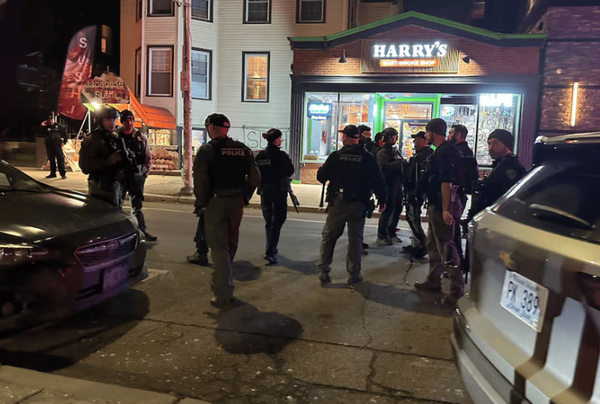On a hot, humid summer's day, Tatsuya Tanaka and half a dozen of his colleagues are preparing to enter a home that has been almost entirely swallowed by a landslide.
He must secure the structure with metal supports and crawl inside a narrow space to save an injured victim.
And there's no time to waste.
This is a training drill being carried out by an elite earthquake rescue unit, Tokyo's Fire Rescue Task Forces, as they prepare for Japan's next mega quake.
The exercises are conducted three or four times every month at a training facility on Tokyo's outskirts, and serve as a constant reminder of the many dangers first responders could face when the next big one hits.
"First, the land will shake very strongly, and buildings will collapse," Tatsuya says.
"When buildings collapse, there's a chance fire will break out. Soil liquefaction, which causes buildings to sink, can happen too.
"We may need to go inside collapsed buildings, very small and dangerous spaces. That could trigger fear."
It's a scenario that has played out time and again throughout Japan's history as one of the world's most earthquake-prone countries, straddling four tectonic plates that are constantly pressing and pushing against each other.
Tokyo itself is particularly vulnerable because it sits on the Kanto Plain, which has two oceanic plates pushing up against it.
Most earthquakes are relatively mild, causing some moderate trembling and only minor damage.
But that's not always the case.
Almost two decades ago, the world watched in horror as a magnitude-6.8 earthquake struck the mountainous Niigata prefecture on Japan's west coast.
About 90,000 homes were destroyed, dozens of people were killed, panic and uncertainty spread as communications were cut, and power blackouts forced hospital staff to treat the wounded by torchlight.
Amid the destruction was a miracle: Firefighters managed to save a two-year-old boy who had been trapped in a car under a landslide for four days.
The boy's mother and older sister had died.
It was these images that first inspired Tatsuya to become a firefighter.
"They were really my heroes and they looked very cool to me," he says.
Tatsuya followed his dream and eventually joined the elite unit, where he has now served for eight years.
"When I do my training, I think about disasters that have happened in the past and imagine this training as an actual disaster site," he said.
Since the Niigata quake in 2004, there have been dozens more of varying severity, most notably the earthquake in 2011 that triggered a tsunami and a nuclear power plant meltdown, killing more than 18,000 people.
And experts warn the next devastating tremor is just around the corner.
What will happen when Japan's next mega quake hits?
Earthquakes are a fact of life in Japan, with around 1,500 every year.
Earlier this year, the Tokyo metropolitan government commissioned a study to remind its residents of the many dangers that accompany these larger quakes.
It found there was a 70 per cent chance a magnitude-7.3 earthquake would strike greater Tokyo before 2050.
If the city felt the full brunt, 6,148 people would die, mostly due to collapsing buildings and fires breaking out, the report predicted.
Around 81,000 buildings would be destroyed, and 4.53 million people would be left stranded, unable to return home.
Evacuation centres would be overwhelmed.
Naoshi Hirata, an emeritus professor of seismology at the University of Tokyo, helped write the report with the Tokyo metropolitan government's panel of experts on disaster prevention.
He says Tokyo's residents are familiar with earthquakes, but many do not truly comprehend what a big earthquake would be like.
In such a case, public transport would stop working, power and water would likely be cut for about a week, and people in high-rise apartments would not be able to use elevators for extended periods.
"Not all the people, all the residents, think very seriously about this," Professor Hirata says.
The latest report noted that the number of families living in super high-rise apartments had boomed by 33 per cent since the last report, released 10 years prior.
However, these buildings were specifically designed to withstand large earthquakes and prevent the spread of fires, leading to a sharp reduction of the death toll and property destruction by 30 to 40 per cent.
The main concern is the many older buildings that were built before strict earthquake regulations came into place in 1981.
Narrow laneways and densely packed wooden structures susceptible to collapse and fire are dotted around Tokyo.
"Those houses are weak. So that's very much a serious problem," Professor Hirata says.
Professor Hirata says the 70 per cent probability of a magnitude-7.3 earthquake striking Tokyo before 2050 was based on past earthquake frequency.
These types of earthquakes strike the greater Tokyo region, on average, every 27 years.
"We did many assumptions to estimate this number," he said.
"One is that previous activity is very similar to future seismic activity. We do not know if this is valid or not. But we simply assume."
While predicting the exact date of an earthquake is impossible, what is certain is a big earthquake is a matter of when, not if. It could be tomorrow.
In the meantime, the Fire Rescue Task Forces are preparing for Day X.
Team leader Kenji Isokawa has been warned about mega quakes since he was a child.
He says that, over the years, the training at the fire brigade has been consistent, but what has improved are the tools and technology that can be used after the disaster strikes.
"We're 100 per cent confident that we can respond," he says.
"But, in many cases, nature exceeds our imagination and abilities."







